QUESTION


This unfolding story comes from a New Jersey homeowner, who had new tile installed in her kitchen in 2019. She writes, “The other day, Panther (one of our cats) propelled himself off the kitchen stool he was sitting on, across the kitchen island and into the great room to chase his sister cat Stella. The result was the damage he did to my new kitchen floor. Does this seem normal with a cat and ceramic tile?”
Further investigation revealed that before this cat-induced damage, the homeowner had a problem with the installation under the dishwasher that resulted in a small crack in one tile. The initial installer would not return any calls, so the distributor sent a second installer who specializes in repairs to address the dishwasher area crack. He agreed the tile under the dishwasher was “unsupported” and planned to fill the crack with grout, but then COVID-19 ripped through N.J. with ferocity and the state went on lockdown, so that repair was not done.
The homeowner revealed that initially, the distributor recommended several installers to put in the tile who either said the job was “too big” or refused it since it entailed ripping up the existing vinyl floor. The installer who agreed to take the job recommended a “mud job” over the existing vinyl instead of ripping it up, and the distributor agreed that was a good approach to take.
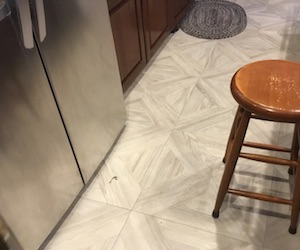
The stool, the floor and the tile damage. 
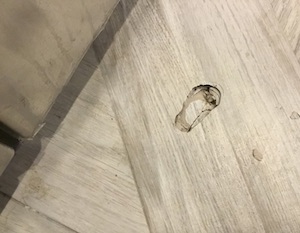
The impact of a stool hitting the tile floor punched a hole clear through the tile to the substrate 
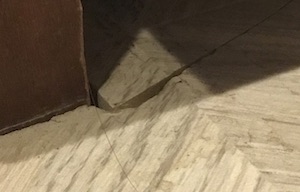
A crack in the tile under the dishwasher that a repair installer had declared “unsupported” several months earlier.
ANSWER
The problem was referred to the NTCA Technical Team. Mark Heinlein, NTCA Technical Director, immediately said from the photos that the installation looked like a “Jersey Set/Florida Mud Bed” job.
Scott Carothers, Director of Certification and Training for the Ceramic Tile Education Foundation (CTEF), added, “It’s time to call the mortician. This floor (based only on what I am able to see in the photos) is dead on arrival and NO, this is not normal.
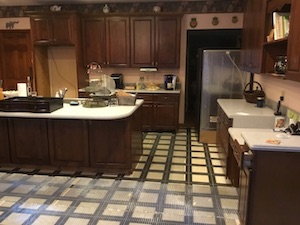

“The cat may be the cause of the problem, but Panther is not the culprit.
“It appears the tile placer (slang for an unprofessional tile person) made a multitude of mistakes. The base of the installation looks like sheet vinyl, a cushioned product, that is compressive. This allows an up and down movement that doesn’t function well with tile products. It should have been removed prior to installing the tile.
“The tile placer did provide a mud job….well sort of. This is what is known in the trade as a ‘Jersey mud job,’ which doesn’t have any TCNA Handbook guidance. It is loosely aligned with detail F145 (page 152 in the 2020 edition) with one fatal error. F145 calls for 2.5# diamond mesh nailed to the vinyl) with the mud bed being 3/4” to 1-1/2” thick. The floor in question, unfortunately, is a skim coat of thinset about 1/4” thick (wrong product and thickness) that has very little strength. The real problem however, is a significant lack of mortar coverage that could be a result of spot bonding or poor troweling technique.
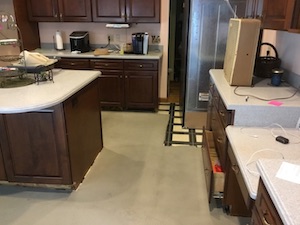

“It MAY be able to be repaired temporarily, but the process may also loosen the surrounding tiles. If the tile is reasonably well bonded to the thinset on the 2.5 diamond mesh, the removal process could pull up more than the broken tile. Also the replacement process should only be attempted if there are enough spare tiles to do the job. The problem is that the diamond mesh can pull up very easily with the tile, and now the larger area around the broken tile is loose, which will cause problems down the road.
“The really sad part here is that this is in the busiest place in the kitchen – in front of the refrigerator.
“The lack of response on the former broken tile call doesn’t bode well with this issue. This is another example of where I apologize to the injured party for the tile industry. This type of work, or the lack thereof, should never occur and gives the legitimate tile industry a black eye.”
In addition, Carothers added that additional photos revealed that the installer used what looked like drywall nails – which will rust – not galvanized roofing nails to nail the mesh to the floor. “Possibly he had not completed his work, but as shown, the mesh is only nailed in the center of the sheet and not along the edges. Additionally, ANSI calls for the mesh to be overlapped 2” at the seam. This one is loosely butted at best.”
Heinlein added, “Another approach could have been – if the installer had been aware of certain uncoupling manufacturer instructions – they possibly could have installed that over well-adhered non-cushioned vinyl (or scraped the cushion off).”
NTCA Trainer Randy Fleming added, “1/4” backerboard, properly installed, would have about the same build up as lath and extra thinset – and may have allowed the existing vinyl to remain.” Heinlein added, “Backerboard would have worked better, but the vinyl – especially if not well adhered or cushioned – has to go.”
The upshot is, the job was badly conceived and installed. Although repairs could be attempted, it is likely that other problems will crop up as the project ages, or undue stress or point loads like catapulting cats sending stools or chairs flying, will reveal more problems in the future. The sad remedy would be to tear out the tile, and have a qualified, knowledgeable installer lay a new floor after tearing up the existing vinyl substrate.






